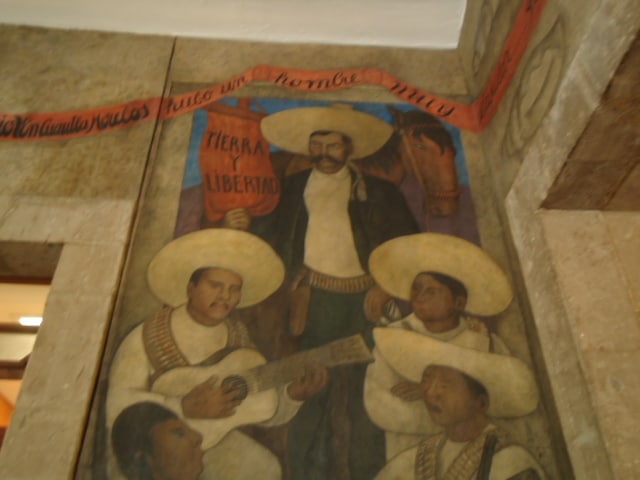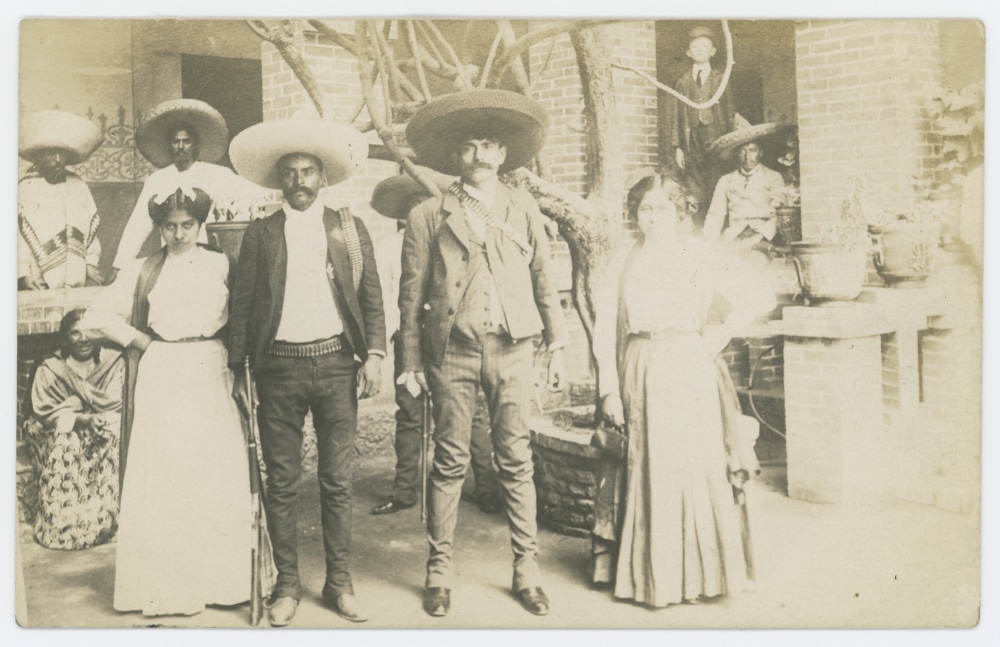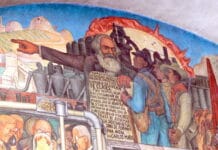
Linkbox om den mexicanske oprørsleder Emiliano Zapata (1879-1919) og den mexicanske revolution 1910-1920.
Tidsskriftcentret, marts 2009.
Revideret april 2019 (Socialistisk Bibliotek).
![Emiliano Zapata. Source : http://memory.loc.gov/service/pnp/ggbain/14900/14906v.jpg Author: Bain News Service, publisher. Public Domain (Library of Congress, Prints & Photographs Division, [reproduction number, e.g., LC-B2-1234]) No known restrictions on publication.](https://socbib.dk/wp-content/uploads/2009/03/Emiliano_Zapata-Libreria_del_Congreso-193x300.jpg)
På dansk om Emiliano Zapata
- Emiliano Zapata (Denstoredanske.dk). Kort leksikon-intro til Zapata og Zapatisterne.
- Emiliano Zapata (Leksikon.org)
Emiliano Zapata myrdes (Arbejderen.dk, 10. april 2007)
“I oktober 1914 slår Zapata sig sammen med den folkelige revolutionshelt Pancho Villa om at skabe en fælles revolutionær bevægelse.”
Se også Socialistisk Bibliotek:
- Tidslinjen: 17. november 1983, om dannelsen af den mexicanske bondeorganisation EZLN – Ejército Zapatista de Liberación Nacional (Zapatisterne).
- Linkboxen: Anarkisme vs. Marxisme
In English about Emiliano Zapata
- Zapata, Emiliano, 1879-1919 (Libcom.org)
- Emiliano Zapata (Wikipedia.org)
- Emiliano Zapata 1879-1919 (Emersonkent.com: History for the relaxed historian). Video clips, movies, biography, maps etc.
- Cultural depictions of Emiliano Zapata (Wikipedia.org)
Emiliano Zapata and the Mexican revolution (Counterfire, 4 November 2013)
“Neil Faulkner looks at the rise and fall of Zapatismo: revolution from below by the common people of the countryside.”
The Mexican Revolution 1910-1917 (Socialist Worker, Issue 1705, 15 July 2000)
“‘Better to die on your feet than live on your knees’ – Emiliano Zapata.”
For land and liberty: Rebels and outlaws (Socialist Review, Issue 170, December 1993)
“The Mexican revolution in the early years of this century changed the country’s whole history. Mike Gonzalez tells the story of its best known leader, Emiliano Zapata, through the turbulent years of struggle.”

About the Mexican Revolution
- Mexicanske revolution (Wikipedia.dk)
- Mexican Revolution (Wikipedia.org)
- Mexican Revolution (Libcom.org). Tags.
The Mexican Revolution was an internationalist revolution. By Jonah Walters (Jacobin, May 26, 2023). Review of Kelly Lytle Hernández, Bad Mexicans: Race, Empire, and Revolution in the Borderlands (W.W. Norton & Co, 2022) and Christina Heatherton, Arise!: Global Radicalism in the Era of the Mexican Revolution (University of California Press, 2022)
“The Mexican Revolution was a transnational explosion of resistance to grinding exploitation that kicked off a global epoch of anti-capitalist revolution.”
One hundred years since Zapata and Villa took Mexico City: The historical significance of the Mexican Revolution. Part 1-3. By Eric London (World Socialist Web Site, 4-6 December 2014)
“The question of the legacy of the Mexican Revolution pervades all aspects of Mexican political life.”
Looking back at the Mexican Revolution. By Dave Fryett (Dissident Voice, December 4, 2013). Review of Adolfo Gilly, The Mexican Revolution: a people’s history (New Press, 2006, 398 p.)
“[The book] is an exhaustive analysis of the Mexican Revolution from a Marxist perspective … And it is brilliant, absolutely brilliant.”
Mexico transformed. By Héctor Agredano Rivera (SocialistWorker.org, March 14, 2013). Review of Stuart Easterling, The Mexican Revolution: A Short History 1910-1920 (Haymarket Books, 2013, 180 p.)
“Haymarket Book’s publication is a welcome introduction to an important struggle that socialists around the world should know more about.”
Mexico’s Revolution Then and Now. By Dominic Alexander (Counterfire, 23 June 2011). Review of James D. Cockcroft’s book (Monthly Review Press, 2010, 176 p.)
“Cockcroft is a veteran activist and scholar of Mexican history, politics and culture. This short, clear but densely-textured book epitomises the Mexican revolution and its history through to today.”
Mexico’s revolution 1910-1920: A look back in the centennial year, Part 1. By Stuart Easterling (International Socialist Review, Issue 74, November-December 2010) + Part 2 (Issue 75, January-February 2011) + Part 3 (Issue 76, March 2011)
“The purpose of this article is to discuss what was achieved with the struggles of the revolution, but also why so many of the possibilities contained within it were left unrealized. To do so will require taking a close look at the course of the revolution itself.”
1810, 1910, 2010 and Mexican labor. By Richard Roman and Edur Velasco Arregui (Against the Current, Issue 149, November/December 2010)
“Mexico is celebrating its two great revolutions, the Revolution of Independence (1810) and the Mexican Revolution (1910-1920) … Both revolutions have provided a set of revolutionary symbols, language and hopes that have not disappeared from popular consciousness.”
U.S. socialists and the Mexican revolution. By Dan La Botz (Against the Current, Issue 149, November/December 2010)
“The Socialist Party, the largest and most important group on the American left from 1900 to 1920, proved incapable of building enduring international labor solidarity during the period of the Mexican Revolution and the First World War.”
Genealogies of the uprisings: interview with Adolph Gilly (Against the Current, Issue 148, September/October 2010)
“Adolfo Gilly is a longtime activist and prominent historian of the Mexican Revolution.”
Viva la Revolución! By Dan La Botz (Against the Current, Issue 147, July/August 2010) + Part 2 (Issue 148, September/October 2010)
“The Mexican revolution, which began in 1910 and ended in 1940, transformed Mexico.”
The Mexican revolution: its past, present and future. By Alan Woods (In Defence of Marxism, 14 July 2010)
“This year marks the hundredth anniversary of one of the great events in modern history.”
På dansk: Den mexicanske revolution: fortid, nutid og fremtid (Revolution, 23. november 2010)
The death of Latin America’s first revolution. By John Ross (CounterPunch, November 30, 2007)
“A specter is haunting Mexico. With the 100th anniversary of the Mexican Revolution … Latin America’s first revolution of the poor and landless, was fraught with nervous anticipation.”
Mexico: State of Revolution. By Peter Taaffe (Socialism Today, Issue 55, April 2001). Review of Frank McLynn, Villa and Zapata: A biography of the Mexican Revolution (Jonathan Cape, 2000)
“Frank McLynn, using the vehicle of a biography of the two main figures of the revolution, Pancho Villa and Emiliano Zapata … gives a detailed picture of the events of the revolution.”
Between history and homage in Reed: Insurgent Mexico. By Judith and John Hess (Jump Cut, No.1, 1974)
“The film is an homage to John Reed, the American writer, journalist, and intransigent radical who covered the Mexican Revolution for four months in the winter of 1913-14.” See also John Reed’s book: Insurgent Mexico (Archive.org). Dansk udgave: Storm over Mexico (Gyldendal, 1980, 236 p.).
The Mexican Revolution of 1910. By Donna Kent (Fourth International, Vol.5, No.9, September 1944)
“The story of Emiliano Zapata and of his role in the Mexican Revolution of 1910 has been brilliantly told by Edgcumb Pinchon, in his book Zapata the Unconquerable.”
Se også/See also:
How the Mexican Revolution made John Reed a Red. By Meagan Day (Jacobin, November 23, 2021)
“John Reed’s thrilling dispatches from the front lines of the Mexican Revolution could have made him a pop culture celebrity. Instead, the experience made him a committed socialist.”
Picturing the revolutionary Mexican working class. By Martin Comack (New Politics, Blog, June 3, 2019). Review of John Lear, Picturing the Proletariat: Artists and Labor in Revolutionary Mexico, 1908-1940 (University of Texas Press, 2017, 366 p.)
“His is a unique study of popular culture in a society undergoing radical renovation.”
The state and the Mexican revolution. By Phil Sharpe (A World to Win, 15 April 2011). Review of James Cockcroft, Mexico’s Revolution: Then and Now (Monthly Review Press, 2010, 160 p.)
“The Mexican revolution of the early 20th century occupies a special place in history … James Cockcroft outlines subsequent people’s movements in Mexico in a vivid way.”


































